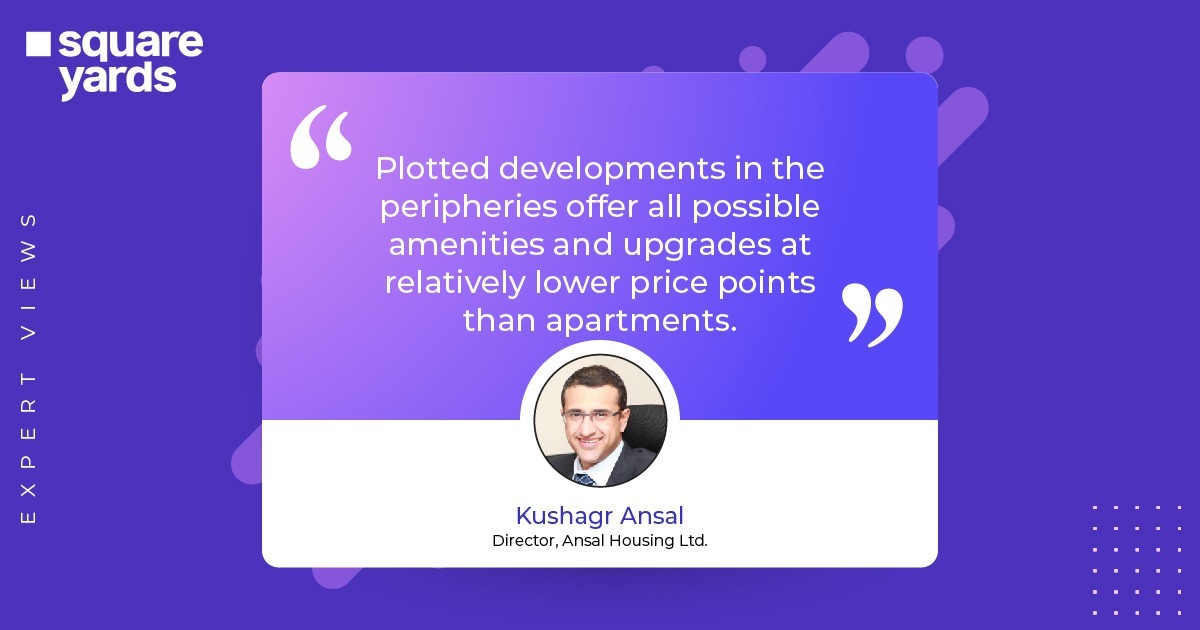This year has witnessed multiple COVID-induced trends in the real estate sector. One such trend has been the rise of plotted developments. Kushagr Ansal, Director, Raheja Developers, spoke to Sruthi Kailas, Square Yards about the growing demand for plotted developments in the post-COVID era.
What according to you has been the most long-lasting impact of COVID on residential real estate?
The pandemic has had a long-lasting impact on residential real estate, the most prominent one being buyers becoming more conscious about the range of amenities provided. Wellness, value for money, availability of multiple social and personal amenities within the premises, or in the proximity of the project are what genuine buyers are now looking for. The changes from the developers’ end have been in terms of digital integration, changes in reaching out to prospective customers, investors etc. However, if the momentum created by the combination of flexible government policies and renewed buyer’s interest continues, residential real estate will be well on its way to recovery in the coming year.
Multiple reports and surveys have shown a growing demand for plotted developments, particularly since the lockdown? Your comments on this?
The most substantial impact of COVID on the residential real estate has been the demand for plotted developments in metro and Tier II cities. We are getting positive responses from the investors specially for this segment. This trend can last upto the time vaccine distribution happens in full pace. It is too early to predict if this trend will sustain once things start getting back to normal. The COVID times are sensitive, and are bound to project multiple inflection points. It is crucial to have a thorough understanding before coming down to any conclusion.
What are the possible reasons for this trend?
The possible reasons could be the need to reside and work in more open spaces. However, open spaces mean higher ticket sizes. At a time when everyone is struggling with limited cash flows, plotted developments in the peripheries offer relatively lower price points than ready-to-move-in units with all possible amenities and upgrades.
Is this trend largely restricted to the southern markets? Why?
No, I do not believe so. This trend is very much prevalent in Northern states like Punjab, Himachal Pradesh, Uttrakhand and UP as well. The hilly terrains of Uttarakhand and Himachal Pradesh make them ideal for plotted developments as high rises need expertise in engineering and construction technology along with special permissions as well.
Which cities do you expect to do well in terms of demand and sales volume w.r.t to plots?
Despite the lockdown, the UP government has time and again announced big-budget infrastructure developments like expressways, airports, etc. Cities such as Lucknow and Meerut from UP, Karnal, Yamuna Nagar, and Amritsar from the states of Punjab and Haryana have been garnering maximum inquiries in terms of demand for plots. We have noticed that plotted developments present at peripheral locations of cities are also grabbing the interest of investors and end-users now, which used to be rare during pre-COVID times.
The supply of plotted projects has also increased in recent times, particularly with more Grade-A developers entering this space. What are the economic and strategic reasons for the same?
Grade-A developers bring a sense of commitment and trust in the projects they undertake. They have a stable capital inflow, along with a dedicated team to take care of crisis situations such as the lockdown. This has helped them stay insulated to some extent towards any severe impact of the lockdown. The festive times saw them coming back to the market and reaching out to their investors with unique and customized investment opportunities, that were never so prevalent in the real estate sector for segments like plotted developments.
What are your expectations from 2021 with respect to recovery of the real estate sector?
We see recovery happening gradually, although it is too early to predict for the complete year. If businesses and supply chains keep running without any disruptions anymore, normalcy is slated to return somewhere towards the end of the second quarter. The real estate sector has gone digital in terms of its various operations, there still remains a lot of scope and upgrades to be introduced for faster approval and sales. Hopefully, we would be able to see the Real estate 2.0 version, equipped with digital marketing, and tech-based personalized solutions for every customer with the help of Artificial Intelligence (AI)




